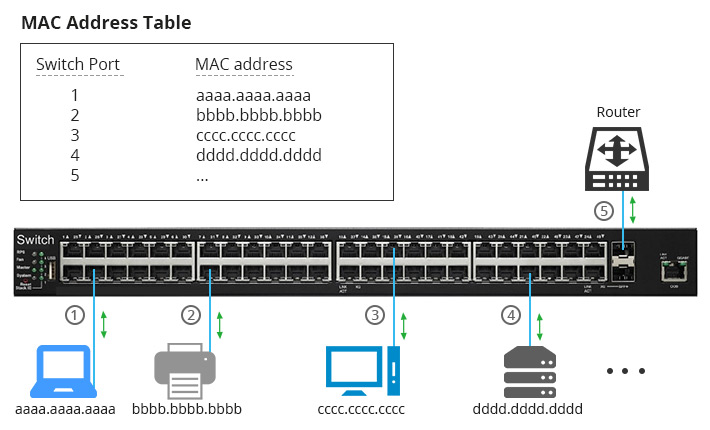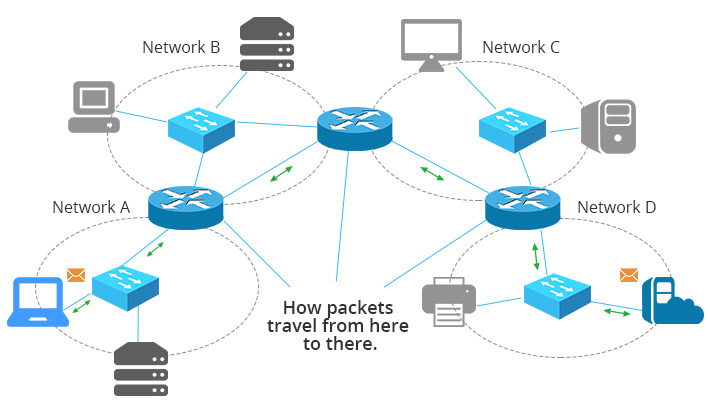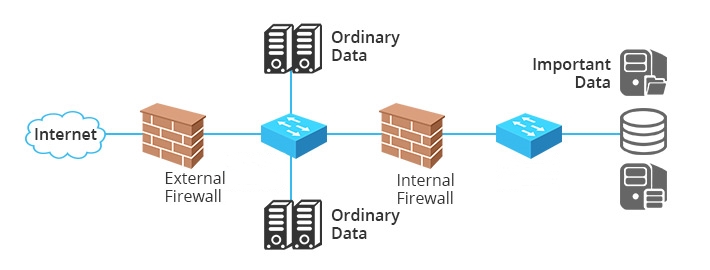Network Switch vs Network Router vs Network Firewall
There are three basic devices that are utilized in almost every network—network switch, network router and network firewall. They can be integrated into one device for small size networks such as for home networking, but it will not be the case for larger networks. For any network, none of the three devices can be dismissed. Learn to know how they work and how they build your network in this post.
Network Switches: Bridging Connections in Networks
In a local area network (LAN), network switch functions similar to the overpasses in cities that bridge other network devices, like switches, routers, firewalls and wireless access points (WAPs), and connect client devices, such as computers, servers, Internet Protocol (IP) cameras and IP printers. It provides a central place of connections for all the different devices on the network.
How Does a Switch Work?
A switch switches data frames by keeping a table of what Media Access Control (MAC) addresses have been seen on which switch port. MAC address is a burnt-in mark in the hardware of a network interface controller (NIC). Every network card and every port of switches and routers has a unique MAC address. The switch learns the source and destination MAC addresses from the data frames and keeps them in the table. It refers to the table to determine where to send the frames that it receives. If it receives a destination MAC address that it does not have in the table, it floods the frame to all switch ports, which is known as broadcast. When it receives a response, it puts the MAC address in the table and it does not need to flood next time.

Figure 1: A switch learns MAC addresses from the data frames.
Router—Connecting with the Internet
A router is a device that connects networks and enables the sharing of data between them. It manages traffic by forwarding data packets to their intended IP addresses and allows multiple devices to use a single internet connection. Routers use the Internet Protocol (IP) to send data packets and determine the best path for forwarding them to their destination. They play a crucial role in connecting Local Area Networks (LANs) and Wide Area Networks (WANs), ensuring efficient and reliable communication between devices across different networks.
How Does a Router Work?
Routers operate by guiding and directing network data through packets that contain various types of information, ranging from files and communications to web interactions. These data packets consist of multiple layers, with one layer carrying crucial details such as the sender's information, data type, size, and most importantly, the destination IP (Internet Protocol) address.
A router checks the source and destination IP addresses of each packet, looks up the destination of the packet in the router’s IP routing table, and routes the packet to another router or a switch. The process keeps happening until the destination IP address is reached and responds back. When there is more than one way to go to the destination IP address, routers can smartly choose the most economical one. When the destination of the packet is not listed in the routing table, the packet will be sent to the default router (if it has one). If there’s no destination existing for the packet, it will be dropped.

Figure 2: How routers route packets from the source to the destination.
Generally, your router is provided by your Internet Service Providers (ISP). Your Internet provider assigns you one router IP address, which is a public IP address. When you browse the Internet, you’re identified to the outside world by the public IP address and your private IP address is protected. However, the private IP addresses of your desktop, laptop, iPad, TV media box, network copier are completely different. Otherwise, the router cannot recognize which device is requesting what.
What Does a Router Do?
Routers prevent broadcast storm. Without a router, a broadcast will go to every port of every device and be processed by every device. When the amount of broadcasts is too large, chaos can occur in the whole network. A router subdivides the network into two or more smaller networks that are connected by it, and it won’t allow the broadcast to flow between subnets.

Figure 3: Broadcast storms occur when there is a large amount of broadcasts.
Switches vs. Routers
Why to compare switches vs. routers? Because Layer 3 switches are able to do routing. Someone may ask why not just use an L3 switch then you need no router at all. Every device has its own features and the choice depends on many factors. On one hand, for instance, for a small network with 10-100 users, an L3 switch is an overkill with regard to the cost or the functionality. An appropriate router can do the job well at a fair cost. On the other hand, you can have switching modules on routers to make it work like a L3 switch according to your needs. So the point of which device to use should consider its scalability, resiliency, software features, hardware performance, etc.
FS is a professional provider of communication and high-speed network system solutions, offering a diverse selection of high-performance Layer 3 switches. For instance, the 24-Port Ethernet L3 switch S5860-20SQ, featuring 20 x 10Gb SFP+, 4 x 25Gb SFP28 and 2 x 40Gb QSFP+ ports. It supports advanced protocols such as RIP, OSPFv2, IS-ISv4, BGP4, etc. Click FS.com for more information.
Firewall—Safeguarding Network
A firewall is a network security device that restricts and controls the flow of traffic between networks. It acts as a barrier between trusted internal networks and untrusted external networks or the Internet. Firewalls enforce security policies to block unauthorized access and prevent cyberattacks. They can be hardware or software-based and are placed at the front line of a network, serving as a communication link between internal and external devices. Firewalls examine incoming and outgoing network traffic based on predefined security rules, allowing authorized traffic while blocking unauthorized or malicious activity. They play a critical role in protecting private networks by managing and securing the flow of data.
Types of firewalls:
-
Packet Filtering Firewalls: Analyze and distribute data based on specific criteria without fully inspecting packets.
-
Circuit-Level Firewalls: Monitor connections and validate interactions based on the TCP handshake.
-
Stateful Firewalls: Track packets and connections, make informed decisions, and block deviations from expected patterns.
-
Application Firewalls: Filter and inspect traffic based on its intended purpose at the application layer.
-
Proxy Server Firewalls: Hide network addresses, validate connection requests, and enhance performance through caching.
-
Next-Generation Firewalls: Combine various inspection techniques, understand application traffic, and adapt to emerging threats.

Figure 4: Firewalls set up a barrier between the Internet and the intranet/LAN.
In addition to separating the LAN from the Internet, network firewalls can also be used for segmenting important data from ordinary data within a LAN. So that internal invasion can also be avoided.

Figure 5: Internal firewall separates important data from others.
How Does a Network Firewall Work?
Firewalls analyze data packets and apply predetermined security rules to determine the validity of incoming and outgoing traffic. By enforcing network policies, firewalls safeguard against hacking attempts, data breaches, and DDoS attacks. With their ability to filter out malicious activity, firewalls play a crucial role in network security, ensuring the safety of sensitive information and defending against potential threats.
Switch, Router, Firewall: How Are They Connected?
Usually router is the first thing you will have in your LAN, a network firewall is between the internal network and the router so that all flows in and out can be filtered. Then the switch follows. Since many Internet providers are now providing Fiber Optic Service (FiOS), you need a modem before the network firewall to turn the digital signal to electrical signals that could be transmitted over Ethernet cables. So the typical configuration would be Internet-modem-firewall-switch. Then the switch connects other network devices.

Figure 6: How a switch, router, and firewall connect to a network.
Summary
Switches enable internal communication in your LAN; routers connect you to the Internet; firewalls secure your network. All the three components are indispensable in a network. Small networks may have an integrated device of the three, while large networks like enterprise networks, data centers, your Internet service providers will have all these three to keep multiple, complex and highly-secured communications. Click FS.com for more high-performance network switches and routers.
Related Articles:
Managed vs Unmanaged Switch: Which One Can Satisfy Your Real Need?
Comparison Between Store-and-Forward Switching and Cut-Through Switching
You might be interested in
Email Address

-
PoE vs PoE+ vs PoE++ Switch: How to Choose?
May 30, 2024














